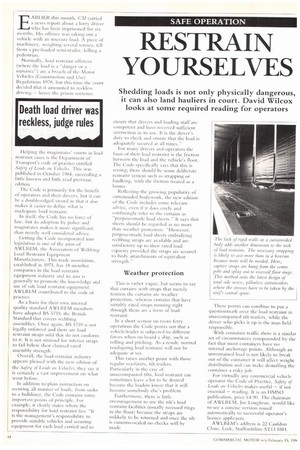RESTRAIN YOURSELVES
Page 44

If you've noticed an error in this article please click here to report it so we can fix it.
Shedding loads is not only physically dangerous, it can also land hauliers in court. David Wilcox looks at some required reading for operators
EARLI ER this month, CA/ carried a news report about a lorry driver who has been imprisoned for six months. His offence was taking out a vehicle with an insecure load. A piece of machinery, weighing several tonnes, tell from a pre-loaded seini-trailer, killing a pedestrian. Normally, load restraint offences (where the load is a "danger or a nuisance") are a breach of the Motor Vehicles (Construction and Use) Regulations 1978, hut this tulle the court decided that it amounted to reckless driving — hence the prison sentence.
lielping the magistrates' courts in load restraint cases is the Department of Transport's code of practice entitled Sakty of Loads on Vehicles. This was published in October 1984, succeeding a little known and little read previous edition.
The Code is primarily for the benefit of operators and their drivers, hut it can he a double-edged sword in that it also makes it easier to define what is inadequate load restraint. In itself, the Code has no force of law, but its adoption by police and magistrates makes it more significant than merely well considered advice. Getting the Code incorporated into legislation is one of the aims of AWLREM, the Association of Webbing Load Restraint Equipment Manufacturers. This trade association, established in 1975, has 18 member companies in the load restraint equipment industry and its aim is generally to promote the knowledge and use of safe load restraint equipment. AWLREM contributed to the code of practice. As a basis tbr their own internal quality standard AWLREM members have adopted BS 5759, the British Standard that covers webbing assemblies. Once again, BS 5759 is not legally enforced and there are load restraint straps sold that do not conform to it. It is not unusual for inferior straps to fail below their claimed rated assembly strength.
Overall, the load restraint industry appears pleased with the new edition of the Safety of Loads on Vehicles; they say it is certainly a vast improvement on what went before.
In addition to plain instruction on securing all manner of loads, from sacks to a bulldozer, the Code contains some important points of principle. For example, it clearly states where the responsibility for load restraint lies: "It is the management's responsibility to provide suitable vehicles and securing equipment for each load carried and to ensure that drivers and loading staff are competent and have received sufficient instruction in its use. It is the driver's duty to check and ensure that the load is adequately secured at all times." For many drivers ;old operators the basis of their load restraint is the friction between the load and the vehicle's floor. The Code specifically says that this is wrong; there should be sonic deliberate restraint system such as strapping or baulking, with the friction treated as a bonus.
Reflecting the growing popularity of curtainsided bodywork, the new edition of the Code includes some relevant advice, even if it does coyly and confusingly refer to the curtains as "purpose-made load sheets." It says that sheets should be regarded as no more than weather protection. "However, purpose-made load sheets embodying webbing straps are available and are satisfactory up to their rated load capacity provided the straps are secured to body attachments of equivalent strength.''
Weather protection
This is rather vague, but seems to say that curtains with straps that merely tension the curtains are weather protection, whereas curtains that have suitably rated straps running right through them are a form of load restraint.
In a short section on ro-ro ferry operations the Code points out that a vehicle/trailer is subjected to different forces when on board 3 ship, such as rolling and pitching. As a result, normal road-going load restraint will not be adequate at sea. This raises another point with those regular sea-farers, tilt trailers. Particularly in the case of unaccompanied tilts, load restraint can sometimes leave a lot to be desired because the loaders know that it will become somebody else's problem. Furthermore, there is little encouragement to use the tilt's load restraint facilities (usually recessed rings in the floor) because the straps are unlikely to be returned and once the tilt is customs-scaled no checks will be made. These points can combine to put a questionmark over the load restraint in unaccompanied tilt trailers, while the driver who picks it up is the man held responsible. With container traffic there is a similar set of circumstances compounded by the fact that most containers have no internal anchorage points. Although an unrestrained load is not likely to break out of the container it will affect weight distribution and can make destuffing the container a risky job. For virtually any commercial vehicle operator the Code of Practice, Safety of Loads on Vehicles makes useful — if not essential — reading. It is an HMSO publication, price .4.90. The chairman of AWLREM, Joe Loughran, would like to see a concise version issued automatically to successful operator's licence applicants.
AWLREM's address is 22 Cauldon Close, Leek, Staffordshire sT13 5SH.






















































